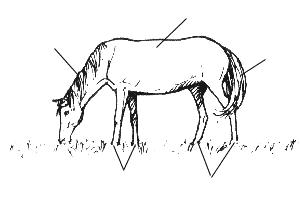One of the questions that may arise during the operation of old houses is how to remove a clog in the toilet. Oddly enough, it is this one that arises most often among others and therefore requires detailed study.
The occurrence of various problems with sewerage is unknown only to residents of new buildings. All other people, whose housing was built decades ago, sooner or later have to face similar problems. Some of them are associated with gradual functional wear and tear of the system. Others are caused by something falling into the drain and clogging it. Both types of sewerage problems are quite common.
The most effective methods
Residents of private houses built more than 10-15 years ago, and happy owners of apartments in Khrushchev-era buildings, sooner or later face a problem that can sometimes be extremely difficult to solve. It consists in the formation of a blockage in the toilet. What can we say, such a turmoil can completely disrupt the rhythm of life of an entire family. Wherein biggest problems occur when the toilet and other plumbing fixtures are connected to a common sewer network.
Everyone at least once in their life has been faced with solving the problem of how to unclog a toilet.
Before you take active steps to deal with a disaster, it is important to assess the situation.
If contaminated water overflows and threatens to flood your home, call emergency services and the property management company immediately.
Even in the middle of the night, on a weekend, and you are not a permanent resident, all this no longer matters.
The emergency situation must be resolved by emergency services.
It is also necessary to shut off the sewer riser and notify other residents.
All this should be done by utility services while you perform emergency actions while waiting for the emergency crew.
But if the situation is unpleasant, but not critical, the toilet is clogged, water accumulates and passes very slowly, when the water is flushed, the drains rise in the bathroom sewer hole, bad smell, you can start looking for the blockage and try to find out How to clear a clogged toilet yourself.
It is necessary to eliminate the cause of clogged pipes, since improper operation of the sewerage system threatens the sanitary condition of the premises.
Blockages usually occur in bends, transitions, and pipe joints.
On a straight and smooth section of new pipe, pipe obstruction is unlikely. In old cast iron pipes, overgrown from the inside with various deposits, anything is possible, but then it is urgent to completely replace the sewer risers.
What can cause a clogged pipe?
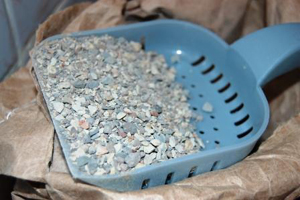 Thick paper, newspapers, unshredded food waste, rags, sponges, congealed fat, any objects that accidentally fell into the drain, clumps of hair, plastic bags, used hygiene products.
Thick paper, newspapers, unshredded food waste, rags, sponges, congealed fat, any objects that accidentally fell into the drain, clumps of hair, plastic bags, used hygiene products.
Recently, clumping chemical cat litters have been added to the usual causes of pollution.
Such products literally cement the sewer, creating complete obstruction. In this case, only professionals can clean the pipes using special tools.
To avoid sewer obstruction, it is highly advisable to place a convenient bucket with a lid for paper waste in the toilet. If all neighbors in the riser do the same, the likelihood of traffic jams in the sewer will be minimized.
What cleaning products are there?
Remedies and methods for toilet blockages can be divided into the following groups:
- 1. Chemicals and rinsing.
- 2. Mechanical means without pipe examination
- 3. Deep mechanical means(plumbing cables)
- 4. Technical. Dismantling of corrugations, a section of pipe, complete or partial replacement of the pipeline. In such cases, it is better to call emergency services.
The common goal of all methods is to clean the clogged section of the pipe and remove contamination.
Chemical methods for cleaning pipes
Hot water
If you are confident in the quality of your plumbing, try unclogging the toilet by pouring a bucket into the toilet hot water. Be careful, the water should be hot, but not boiling water. You need to fill the toilet to 80% and wait a couple of minutes, then try to break through the blockage with a plunger or simply flush the water.
By the way, this method works great if you clog the toilet with cat litter.
A simple way - a bucket of hot water with soda
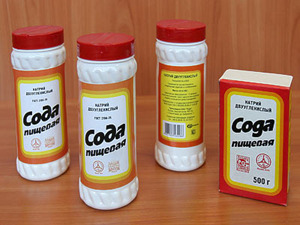 A bucket of water will require about half a pack of soda.
A bucket of water will require about half a pack of soda.
This is a rather aggressive composition, but it will not be able to cause damage to pipes.
Baking soda effectively dissolves various organic contaminants and fats.
By the way, soda washes away burnt fat no less effectively than vaunted branded gels.
Another thing is that soda can simply clean off a Teflon surface due to its slight abrasive effect.
If the cork is soluble, then a hot soda solution will remove it.
Mole and its modifications
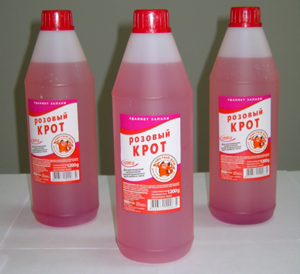 Acid-based products do not dissolve blockages, but they can seriously damage the pipes.
Acid-based products do not dissolve blockages, but they can seriously damage the pipes.
“Mole” is practically not suitable for cleaning the toilet due to the presence of a water lock.
In the pipe, that is, on workplace"Mole" will only arrive in a very diluted form, absolutely incapable of dissolving the blockage, but completely damaging the pipe.
Why are acid products not effective? The answer to this question lies in the chemistry course of the 8th-9th grade of high school and in the selective action of various acids. Acids that dissolve organic matter do not dissolve polyethylene, and it is plastic bags that cause half of the blockages.
Acids that dissolve polyethylene do not dissolve organic matter, but easily dissolve plastic areas pipes and some metal structures.
The use of "Mole", effective in past decades, before the significant proliferation of plastic packaging, was very effective.
Currently, “Mole can be successfully used to dissolve organic blockages in the sewers of private houses.
Fairy tricks
It’s better to really pour half the bottle of “fairy” down the toilet. If the blockage is fatty, “fairy” will dissolve it without difficulty. But grease clogs, which are common in kitchens, are quite rare in fecal drains.
Shampoos and regular foaming products detergents It is highly undesirable to flush it down the drain.
Folk remedies “Pepsi and cola”
Effectively removes yellow plaque and stains from plumbing fixtures. This is true. This is where the benefits of these drinks end.
Of the presented remedies, the most effective is a solution of baking soda in hot water..
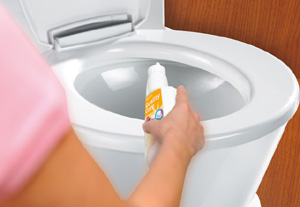 We will not consider options with a bleach solution and pouring bottles of “whiteness” into the sewer.
We will not consider options with a bleach solution and pouring bottles of “whiteness” into the sewer.
Chlorine solutions are effective in preventing blockages when used regularly.
Several decades ago, disinfection of sanitary facilities with chlorine was a mandatory procedure in all public places.
In clinics, hospitals, first aid stations, government agencies. This procedure was abandoned due to the harmful effects of toxic chlorine fumes on the body. Modern disinfectants have a viscous structure and differ more long term action compared to liquid solutions and less harmful fumes.
Usage disinfectants V cistern or in the toilet bowl reduces the risk of blockages.
Mechanical cleaning methods
Mechanical methods Pipe cleanings are generally different. greater efficiency compared with chemical methods. Exist household methods removing obstructions, such as a plunger and more technologically advanced ones, to remove blockages deep inside pipes, using plumbing cables.
Using a plunger
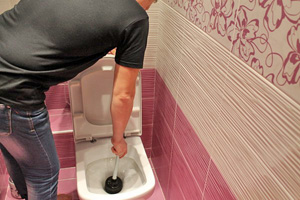 The plunger is necessary tool for effective removal of small blockages.
The plunger is necessary tool for effective removal of small blockages.
The plunger creates hydraulic tension in the pipe, which destroys and pushes most of the contaminants forward.
How to use a plunger?
Take the plunger by the handle, place the suction cup over the drain and perform 5-10 sharp and strong pushing movements. Unstick the plunger and repeat the procedure if necessary.
Usually, several approaches and about 10 minutes are enough to remove the contamination. After eliminating contamination, for preventive purposes it is good to pour one or two buckets into the toilet warm water with soda.
The plunger must be kept clean and placed in a disinfectant liquid after use or rinse thoroughly.
Plastic bottle
 In case of emergency, a plastic bottle can replace a plunger.
In case of emergency, a plastic bottle can replace a plunger.
How to use a pipe cleaner bottle?
The bottom is cut off from a plastic bottle, the cap is screwed tightly, and with the resulting device you can try to create a hydraulic wave, like a plunger.
After use, the contaminated bottle should be immediately disposed of in the trash.
Using a plumbing cable
There are several modifications.
From household devices, no more than 5 meters long, to professional devices, which can easily break through a blockage in a toilet or pipeline.
An ordinary plumbing cable is an elastic, springy metal cable with a handle.
The cable is carefully inserted into the plumbing fixture and rotates, pushing through and destroying the cause of blockages. A metal brush is often made at the end of the cable, with which you can remove the object that caused the obstruction.
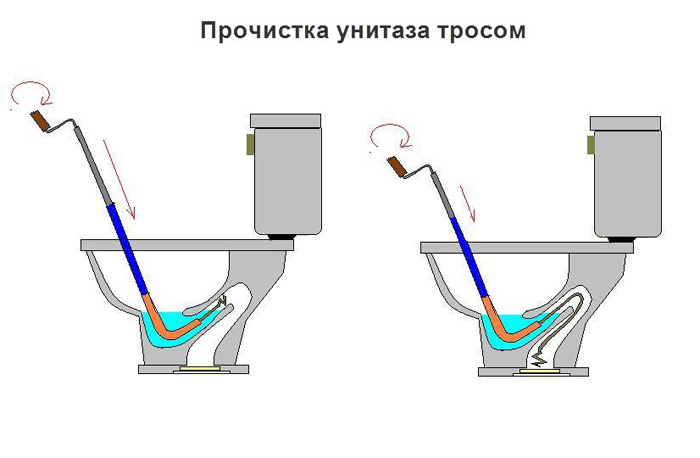
If the cause of the clogged pipe cannot be eliminated, contact a plumber. servicing your home. Eliminating the cause of a blocked tube may take long time and require specialized knowledge and skills.
In order not to take on unnecessary responsibility for flooding your neighbors with fecal matter as a result of unprofessional actions, it is better to seek help from specialists.
Video on the topic
At any modern apartment The toilet is an important element of toilet plumbing. Therefore, for apartment owners there is no more unpleasant situation than its clogging, disrupting the operation of the sewer system. After all, they have to decide without delay when the toilet is clogged and how to clean it at home. Of course, the easiest way is to call a plumber, but in this case there is the prospect of being left without a toilet for several days. For a family with children, this is a real tragedy. Therefore, it makes sense to learn how to cope with such a problem on your own.
Possible causes of a traffic jam
Before you begin to fix the problem, you need to understand what caused it.
Clogging often occurs for one of the following reasons:
- installation of a plumbing fixture performed with obvious violations;
- improper operation and negligent attitude towards the device by household members;
- a thick layer of sediment, formed due to hard water and insufficient preventive measures, covering the inner walls of the sewer pipe.

Salt deposits on the walls of the sewer pipe.
Another common cause of clogged plumbing is waste that is stuck in the drain and cannot be disposed of through the drain. For example, you can easily create a blockage in the toilet drain system with one discarded diaper. Inside it there is an absorbent pad, which in the water will begin to swell greatly and increase, as a result the pipe hole will be completely clogged. Likewise, pipes can become clogged when the contents are washed down the drain. cat litter. In such situations, you need to start cleaning the pipe as quickly as possible, before the sewer system “stops.”
Remember! To prevent clogged drains, do not flush food and household waste down the toilet. It's best to use a trash can.
TO possible reasons Frequent blockages can also be attributed to errors made by manufacturers in the manufacture of plumbing fixtures. They often focus on the design of models and equipping them with various devices, without caring about the performance of the entire structure. In this case, you should think about replacing the plumbing.
Checking the location of the blockage will allow you to find out what and where the blockage could be. First you need to check whether the water drains well from the bath and kitchen sink. If the water drains normally in these places, there is no doubt that it is the toilet that is clogged. Now that the cause of the formation and location of the traffic jam have been determined, you can think about how to solve this problem. 
To check the degree of clogging of the toilet, do not use draining water from the barrel, as there may be enough water for all the contents to spill out. It is enough to pour in just a liter of water to understand whether it is a “solid” blockage or whether the water is still flowing a little inside.
Methods for removing blockages
There are three ways to unclog a clogged toilet:
- Manual;
- Mechanical;
- Chemical.
If the design of the toilet allows it, then first you can try to manually remove the blockage by wearing a rubber glove. If you don't have rubber gloves on hand, this will do plastic bag, wearing on hand. This method makes sense if you know exactly what caused the blockage.
Mechanical cleaning is performed using various devices:
plunger
This simple but effective device Many housewives use it in the kitchen to clean the sink drain hole. It is also indispensable in the toilet when removing blockages that are located shallowly. A plumbing plunger consists of a cup-shaped rubber suction cup placed on an elongated, usually wooden handle. Under the influence of hydraulic pressure created by water and air when pumping the tip of the plunger, it collapses and is pushed forward most of pollution.
When using a plunger, the following steps are performed:
- water is poured into the toilet bowl;
- bring the suction cup of the plunger to the drain hole, closing it as tightly as possible;
- do 5-10 pumpings, sharply pressing the plunger handle;
- After pumping, the suction cup is peeled off.
Sometimes it is not possible to clear a blockage with a plunger immediately, but after several attempts.
Important! To create sufficient hydraulic pressure, the tip of the plunger must be slightly larger than the drain hole.
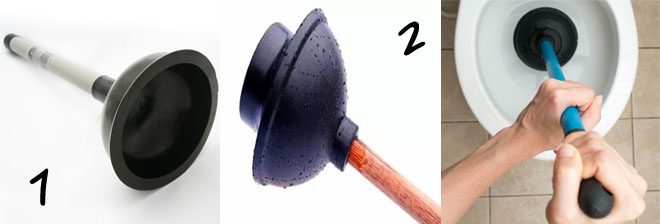
Types of plungers: 1. For unclogging the sink 2. For unclogging the toilet.
If you haven’t had time to get a plunger, and your toilet is already clogged, what to do at home - don’t despair, you can replace it with a plastic one and a half liter bottle. First, the empty bottle is tightly capped and the bottom is cut off. Then, holding the bottle by the neck with your hand, insert it into the drain hole until the water begins to resist. After this, they begin to press on the sides of the bottle so that the water pushed out of it puts pressure on the blockage and pushes it forward.
After cleaning, for preventive purposes, it is good to additionally rinse the drain with two buckets warm water with soda.
Plumbing cable
This device is usually used by plumbers, but it is so simple that anyone can handle it. The cable is made of wire that is tightly twisted into the shape of a hollow flexible tube. On one side, the cable ends with an L-shaped handle. On the other hand, the wire is twisted in a spiral on a small section; this end of the cable is used as a punch. Technical cables used by plumbers can be up to 50 meters or more in length. In an apartment, you won’t need a very long punch, since you can clean the toilet at home with a three-meter cable.
To clean the drain with a technical cable, you need to perform the following steps:
- lower the end of the cable with the punch into the toilet drain and push it all the way;
- then start turning the handle in one direction until the cable manages to pass through the plug;
- when the blockage begins to move, you should continue to rotate the cable to push it further along the pipe;
- if the cable, passing through the blockage, could not destroy it, you can try to pull the plug out by pulling the cable towards you.
![]()
After completely cleaning the pipe, it is necessary to do additional flushing.
If the toilet clogs regularly and the house still uses old ones for sewerage cast iron pipes, then think about replacing them with more modern plastic ones. Plastic pipes have more smooth surface walls and they are less prone to clogging.
Sometimes it is better to resort to strong remedies
It may happen that if there is a significant blockage in the pipe, mechanical cleaning will not be enough and you will need to move on to more radical measures, such as cleaning drain system toilet bowl with strong chemicals. In stores you can find such products, expensive and relatively cheap. When choosing chemicals remember that expensive formulations may actually be ineffective.
From those presented on store shelves effective means can be distinguished:
- “Mole” is a product that belongs to the budget segment, but it can easily clear a clogged toilet. Action caustic soda It is enhanced by various additives. Available in two forms: gel and powder. Using this product, it is possible to dissolve fatty deposits and a number of solid biowaste, in particular hair, which often accumulates in the drain hole. At the same time, “Mole” is safe for pipes.
- Vortex Draft is an expensive product that is only available in liquid form. It consists of caustic soda, chlorine and surfactants; these active ingredients cope well with blockages and do not harm pipes.
- "Tiret" is a product similar in composition and action to Vortex Draft.
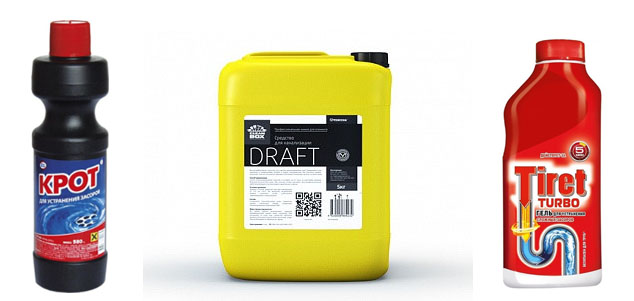
You will be surprised, but you can make your own drain cleaner at home. For this you need baking soda and table vinegar. Pour a pack of soda into the toilet, after pumping out the water from it, and add 200 ml of vinegar. will happen chemical reaction which will clear the blockage. Wait 20-30 minutes, then flush the toilet with two liters of hot water (do not use boiling water).
If the methods listed in the article did not help, then most likely the common riser of the house is clogged. In this case, you need to urgently call the organization servicing your home to fix the problem.
Those who are against the use of strong chemicals at home and others can be advised to be careful and try to prevent foreign objects from getting into the toilet. Don't forget about preventive measures, then you won’t have to clean the clogged toilet in emergency mode.
Advice! Prevention sewer pipes should be carried out at least once a quarter. For these purposes they are used industrial products for cleaning pipes. Simply pour the liquid into the pipe and leave it overnight, and rinse with plenty of water in the morning. This procedure will remove all salt deposits and prevent stone formation in the pipes.
With this trouble, residents apartment buildings encounter at least once in a lifetime. In old houses, where the sewage system leaves much to be desired, blockages often become a real disaster. It takes time to wait for a plumber. But, if you have the desire, you can easily remove the blockage yourself. In this article we will learn how to unclog a toilet, and we will also look at several cleaning methods.
Finding the cause of the blockage
As a rule, the main causes of blockage are:Large objects getting into the drain: accidentally thrown rags, leftover food or garbage;
The formation of too large a layer of limescale during long-term use of plumbing fixtures; It forms quite quickly even in the presence of excessively hard water;
Illiterate installation of the toilet and the presence of excessive twists and turns in the pipes located at a large angle: this is possible when moving the toilet too far from the drain or installing a “steep” toilet of the latest model, the drain hole (inlet) of which is absolutely not compatible with the hole installed in your apartment.
Chemical compositions for cleaning
If the cause of the blockage is the formation of limescale, you can try to soften it using any quality compounds, intended for this purpose:Domestos: in addition to Domestos itself, the group of these fairly inexpensive and quite effective cleaning products also includes the Cif brand, produced by the same manufacturer;
Domestos-gel
Procter&Gamble: able to cope not only with plaque, but also with rust;
Cillit: a widely advertised product is also quite suitable for cleaning even heavy deposits;
Jonson&Jonson: used for cleaning hard to reach places, has a package in the form of a “toilet duck” - a tube with a curved dispenser spout, which allows you to pour the composition along the rim of the toilet, simultaneously clearing the accumulated plaque in this area;
Tiret: a product for removing limescale deposits and preventing them;
Sanita Gel: another high-quality product from a Russian manufacturer.
If you have already encountered the problem of clogs and know some other brands of products that can clear plaque from your plumbing, you can certainly use them. We have listed only the most well-known manufacturers whose products really work (unless, of course, you buy a fake).
Important! Before using any composition, be sure to read the instructions. Most of these cleaners are designed for use in drains with cast iron or plastic pipes. Unfortunately, steel pipes they can cause damage.
If the clog is small, you can try using a mixture of 9 percent vinegar and baking soda. To do this, you need about half a pack of soda and a glass of vinegar. To enhance the effect, it is better to scoop out excess water from the toilet before doing this.
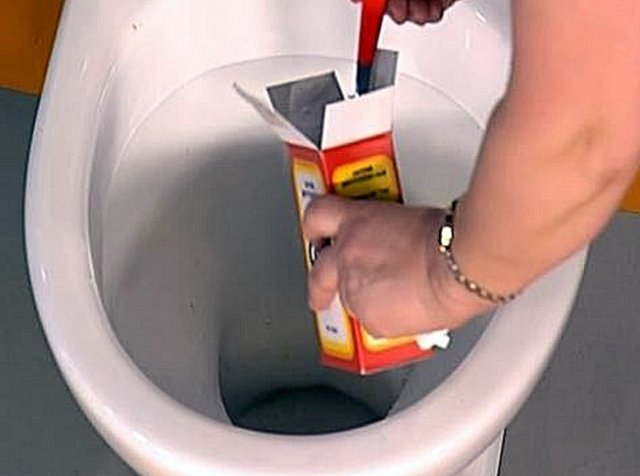
Add baking soda, then add vinegar
Mechanical cleaning of the toilet
The first thing you need to do is make sure that it is the toilet that is clogged. Turn on the faucet, for example, located above the sink or the mixer above the bathtub. If the water flows without problems, then the blockage is in the toilet.
If you know for sure that a foreign object has fallen into the toilet, try to remove it. Perhaps he hasn't gotten very far yet. Put on rubber gloves (if you don't have them on hand, you can use a large, durable bag) and check the drain.
If we are unlucky and the rag or debris has gone too far to be reached by hand, try using a plunger. A tool with a small rubber valve will not work here - its diameter should be slightly larger than the drain. Place it tightly against the edges of the drain hole and begin to make sharp forward movements, pushing the water down. Under the influence of hydraulic pressure, an object that gets into the toilet will be pushed into the general, wider drain.
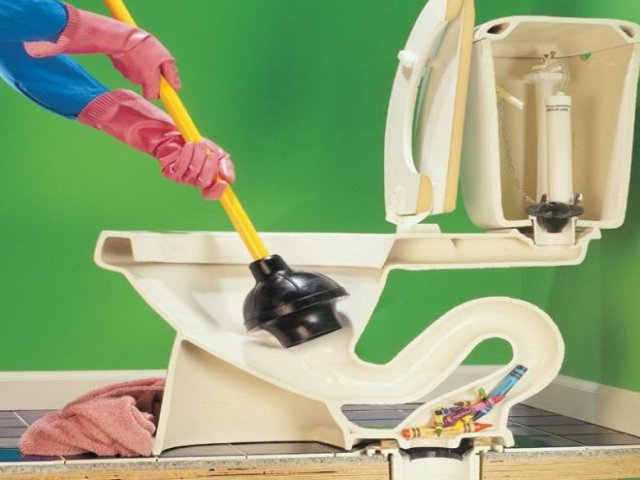
Cleaning with a plunger
Advice. A plunger can be replaced by the cut-off top of a 1.5-liter plastic bottle with a tightly closed lid. To make it easier to capture water, several cuts can be made along its edges.

A plunger will only help if the object falling into the drain is not too large
Cleaning the toilet with a cable
If you don’t have this useful item in your home, be sure to purchase it. After all, plumbers use it to clean all types of pipes. Using a cable, you can remove even compressed, dense and hard deposits from the drain, as well as push through fairly large debris.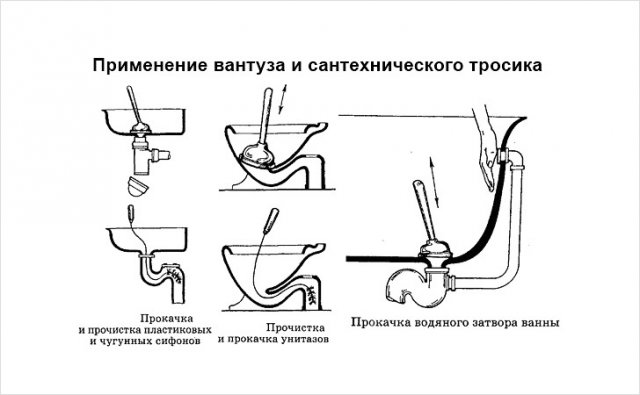
For use in an apartment, it is better to purchase a tool with a diameter of 9 mm and a length of 5 m. At the end of the cable, for convenience, there is a handle that you will rotate. At the other end there is a small tip in the form of a spiral or brush, with which you can crush debris or capture pieces of it.
Since when pulling the cable back out of the toilet, impurities and drops may fall onto the floor and surrounding objects dirty water, cover the area around with old rags or an unnecessary blanket. When punching, it will be better if someone helps you unwind the cable (although you can do it alone).
Lower it into the drain and gradually, without effort, try to push it as far as possible. Keep in mind that you will have to negotiate a few curves, so take your time. As soon as the cable reaches the blockage and rests against an obstacle, begin to rotate the handle. Try to pull out the cable. You may have caught some debris that got into the drain. If nothing happens, push the cable again until it stops and start turning the handle. And so on until the bitter end!

Punching with cable
Prevention
To avoid having to deal with blockages in the future, use the following tips:Do not throw large items or food waste down the drain;
After washing the floors, be sure to check if there is a rag left in the bucket;
For preventive purposes, regularly use modern chemicals to combat limescale; if the water in the house is hard, such prevention should be carried out more often;
If possible, replace old clogged and rusted ones. sewer risers for new ones;
If you find that your toilet is not installed correctly, call a plumber or (if you have at least basic skills) change it yourself.

Video: How to clean a toilet with a plastic bottle
Time runs forward, houses began to be built using new technologies from modern building materials, and the problem of clogged pipes and drains in apartments is still relevant. Often, difficult drainage of water in the toilet can be observed due to salt deposits in the pipes. Hard water sediment, urea and other types of deposits settle on the walls of the pipes and narrow their internal diameter. What to do in this case and how to clear the clog in the toilet?
Check all systems
It is very important to understand whether there is only a blockage in the toilet or whether the water is not flowing well in other rooms where there is running water.
If the drainage is slow everywhere, then most likely there is a problem in the common pipe. Then your neighbors should face the same troubles. Discuss this issue with them and decide together what to do next.
Troubleshooting should be done by you Management Company. If the liquid does not go away at all or flows in a thin stream only in the toilet, then this means that the toilet is clogged. The problem can be solved mechanically, using chemicals or a plunger.
Mechanical method
It often happens that blockages in the sewer system are caused by the residents themselves, who use plumbing equipment as a garbage chute, pouring in the remains of liquid dishes, sending spoiled food and hygiene products. Even an ordinary sheet of newspaper can cause water to stagnate in pipes.
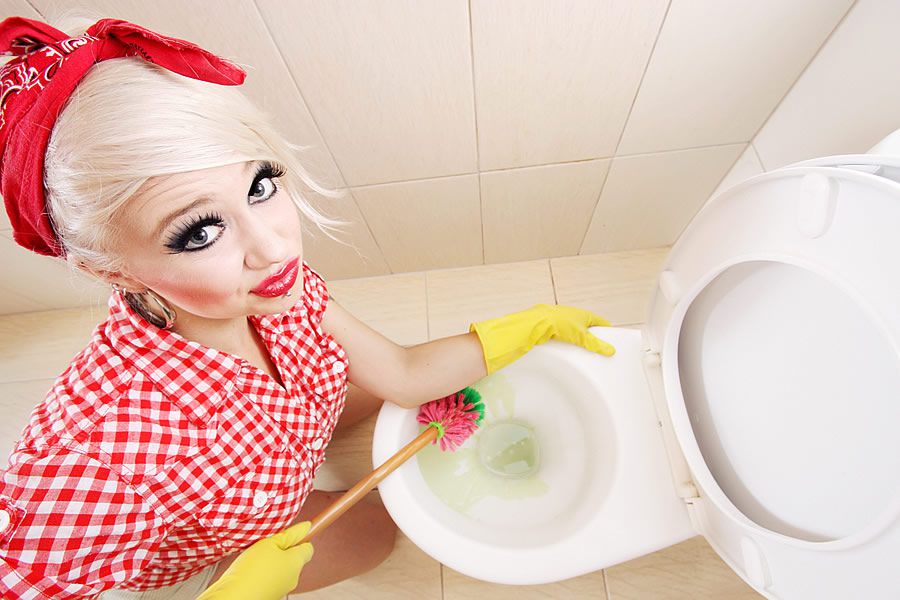
It must be said right away that trying to break it with a large amount of plain water can result in a flood in the toilet.
On the contrary, you should scoop out all the water from the toilet and, armed with long rubber gloves, try to reach as deep as possible and pull out what caused the blockage.
If this event does not lead to anything, go to a specialized store and buy a special plumbing cable.
We assure you that it is not that expensive and will fully justify this expense, since it will come in handy more than once. Such a device can be rope, spring, rigging, tension, etc. It has a metal braid and a handle at the end, which allows you to comfortably grasp it and perform rotational and translational movements. At the opposite end, the cable may have a spiral - for extraction or a weight - for punching.
Stages of cable work:

- What should you do at home if the toilet is clogged? Lower the end with the spiral or weight into the drain, and begin to rotate the handle of the tool in any direction, while simultaneously pushing it forward;
- you need to rotate the cable so that it can overcome the bend of the pipe and move further - to the place of possible accumulation of sewage;
- Having pushed the device as deeply as possible, try to perform various movements with it: move it back and forth, move it from side to side, etc.;
- after that, all that remains is to hope that the cable caught the object that caused all the troubles. By pulling it out, you can be convinced of this or be disappointed.
Working with a plunger or its equivalent
When pulling the cable to the surface, you need to be prepared for the fact that dirty liquid will drip from it onto the floor surface, so you need to remove the soft mat from it in advance. Have a trash can ready to dispose of rags, sanitary products, or anything else stuck in the pipe. Instead of a cable, you can use a flexible wire with a hook-shaped end. And if there is neither one nor the other, a good old plunger will save you.
The main thing is that the diameter of its rubber tip is larger diameter drain hole: this will create the necessary conditions for water hammer to occur.
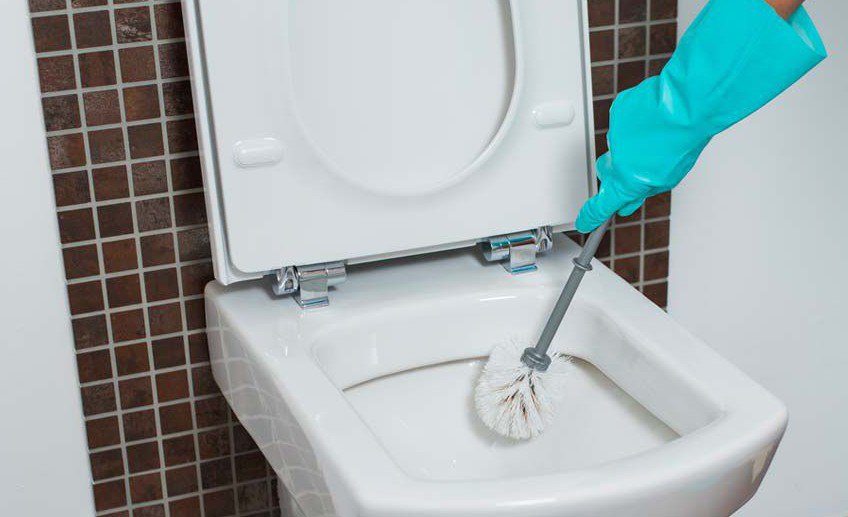
How else can you clear a clogged toilet yourself? If you don’t have this device in your home, take a 1–1.5 liter plastic bottle, cut off the bottom and screw the lid tightly. The container will act as a plunger.
That is, the cut end must be inserted into the drain hole and gradually inserted inside until the air in the cavity begins to push it back out.
With a sharp movement, press the bottle all the way into the drain and immediately remove it out. In some cases, the pressure created is enough to break through the blockage after two or three such operations.
Chemicals
Another life hack that will tell you what to do if the toilet is clogged. Baking soda and vinegar will help clear the blockage. The toilet needs to be emptied of excess water and half a pack of soda must be poured down the drain. Now pour one glass of vinegar into it. An alkaline reaction will occur, which will corrode the salt plug and fight fat deposits. After 15–20 minutes, it is recommended to pour 3 liters of boiling water into the plumbing equipment. But here it is necessary to take into account what material the toilet is made of, that is, whether it is “afraid” of boiling water.
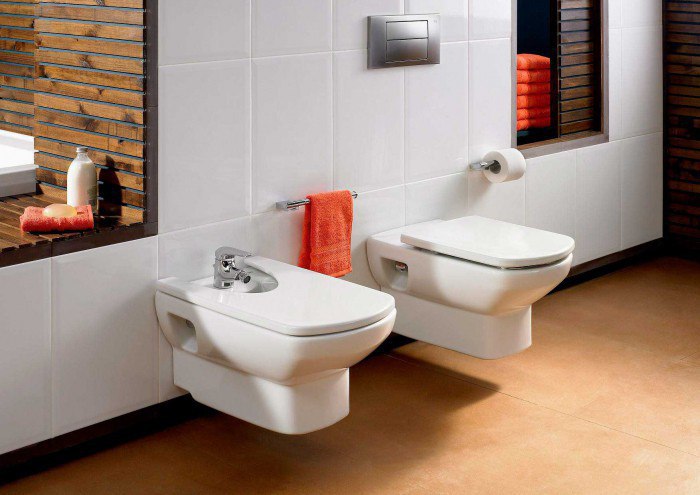
The thin plastic from which the connecting corrugation is made can also resist such sophisticated manipulations and burst. Remember this. It’s better not to risk it and pour not boiling water into the toilet, but just very hot water.
If you are afraid of such experiments, just buy special household chemicals in the store to clear toilet blockages. They are always based on some kind of acid, which corrodes the components of the layers - textile fibers, hair, fatty deposits, etc.
The most well-known remedies include Tiret, Mister Muscle, Mole, Tofix, Domestos, etc.
Using them to break through a blockage at home is as easy as shelling pears: just follow the instructions printed on the container. If blockages have become a frequent occurrence in your home, remedies household chemicals must be used regularly to prevent almost complete narrowing of the pipe lumen by salt deposits and to extend the life of the laid communications.
Now you know how to break through a blockage in the toilet and what to do if an object accidentally falls into it.
A minor problem can be fixed on your own, but a serious problem cannot be solved without the help of professionals. Good luck!








